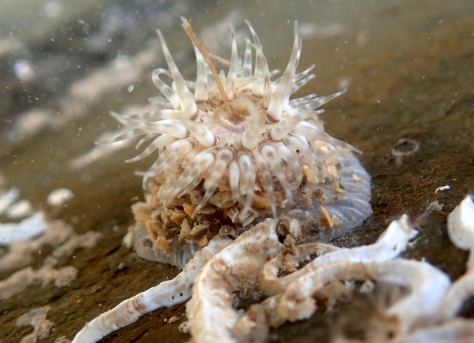The rock pools are full of weird creatures. I come away from most rockpooling trips with photos of strange blobs and odd leggy things that I mean to identify. Some are new to me, some I can’t remember the names of and some are things that look so much like other things they’re worth checking.
While I wait for the return of the spring tides this weekend, it seems a good time to put names to things I’ve tagged ‘to identify’.
First up is a minute shell that Cornish Rock Pools Junior thrust into my hand one day. At around half a centimetre long, it was too much of a challenge to identify in the field, so we took a photo and promptly forgot about it.
Fortunately on-screen in a warm living room it’s much easier to figure out how many whorls it’s got, that the opening has a short canal and that there are three rows of tubercles on each whorl. It has a distinctly unmemorable name: Cerithiopsis tubercularis. These shells live on sponges like the breadcrumb sponge, which is where we found this one.

The next photo is one end of a scale worm – it’s not entirely clear which end, but hopefully the worm knows. After a lot of staring at the arrangement of the bristles and the shape of the scales I’m satisfied that this is Lepidonotus clava.

Among my photos there are others like this Syllid worm that I’m unable to identify to species level. I was taking a photo of the Candelabrum cocksi and by the time I realised it was there it was slithering off down the far side of the boulder.

Sea spiders always need a close look as there are some very similar species. This is a Nymphon gracile. The egg sac it’s carrying looks huge under its spindly, delicate body.

This isopod was hard to photograph as it was especially small and kept walking about on the rock. It had amazingly long antennae, longer than its whole body, making it easy to identify as a Janira maculosa.

Chitons aren’t easy to tell apart with the naked eye, so I usually take a photo of the edges (the girdle) to check the details. This one is a Lepidochitona cineraria with sand-like grains fringed with lots of little spines around the edge. The shell also has a grainy texture.

I still have a pile of photos to go through and I’m half-buried under identification books, but it’s been a great learning exercise. Here are a few more photos that I (think) I’ve identified today. I’ll be back soon with whatever turns up in the rockpools this weekend!







Always good to see you hard at work.
LikeLiked by 1 person
I do like making it hard for myself! There’s so much to learn it boggles my mind, but I still enjoy it. 🙂
LikeLiked by 1 person
I suspect you will never tire of it.
LikeLike